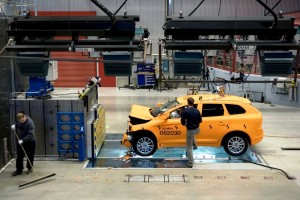Volvo Cars’ crash-test laboratory in Torslanda is ten years old this year. When the new safety center was inaugurated by Sweden’s King Carl XVI Gustaf in early 2000, it was one of the most advanced in the car industry – arguably a position it retains due to the continuous upgrading of equipment and test methods. During this period almost 3,000 full-scale tests that have been carried out.
The crash-test laboratory has one fixed and one movable test track. The movable track can be adjusted from zero to 90 degrees. This allows tests of various incident and accident scenarios, from frontal impacts to side impacts, between two moving cars approaching at different angles and speeds. In addition, avoidance and mitigation of collisions can also be tested. The facility currently can conduct more than 400 full-scale tests a year.
“We can replicate most of the incident and accident scenarios that take place out on the roads. By analyzing these and then testing new safety technology in the crash-test laboratory, we can improve the safety level in our cars so that they become even safer in real-life traffic conditions,” says Thomas Broberg, Senior Safety Advisor at Volvo Cars.
The two tracks meet above a six-meter deep, Plexiglas-covered pit used for filming the collision tests from underneath. Over the years, the Plexiglas shield has witnessed a number of remarkable crash tests.
The latest technology upgrade is a set of digital high-speed cameras that can take 200,000 frames per second.
“The new cameras give us exceptional scope for studying collisions down to the tiniest detail. What is more, we have a number of miniature cameras that are installed inside the cars to capture what happens with various key components in the vehicle,” said Broberg.
Crash tests on both tracks can also be carried out in the opposite direction. At the end of the fixed track, there is a concrete slab that can be used for various tests such as rollovers. At the end of the movable track, the surrounding landscape serves as an integrated part of the crash-test laboratory. Here crash tests are carried out against a variety of objects found in the traffic environment.
The lab’s crash block weighs 850 tons. It is moved around with the help of air cushions. In addition, there are around 20 other fixed and movable barriers covering Volvo’s own test regime, as well as regulatory test requirements. About 100 crash-test dummies – men, women and children of different sizes and ages – are maintained for use.
“The risk of being involved in an accident or being injured in one of our latest car models has been more than halved compared with a Volvo from the 1970s. We are continuously taking new steps towards our vision that nobody should die or suffer serious injuries in a new Volvo car by the year 2020. The crash-test laboratory is a central part of this development,” says Thomas Broberg.

